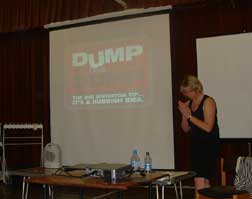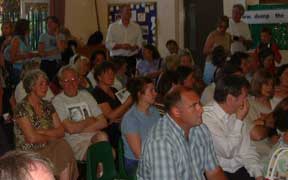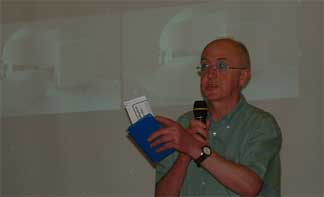Veolia 2006-06-08 Campaign Meeting
Dump The Dump’s Final Response
The meeting on 8th June at Downs Infant School, where the Dump the Dump Campaign presented their final response to the application, was well attended and equally well chaired by parent and local resident Diana Leech. 
Political opposition to Veolia’s Hollingdean Depot proposal
A roll call of local representatives got the meeting under way as Councillors from Preston Park and Hollingbury & Stanmer wards stood to record both their presence and their opposition to Veolia’s proposals.
Local Councillors who will be speaking against the scheme on 19th June include Jeane Lepper, Pat Hawkes, Richard Mallendar and Juliet McCaffery. Councillors Kevin Allen, Tehmtan Framroze, Paul Elgood, Simon Williams and Keith Taylor also oppose Veolia’s proposals. It was explained that Local Councillors who are also Members of the Council’s Planning Applications Sub-Committee are disqualified from voicing opinions in advance of the Planning Meeting on 19th June. Residents will have to attend the Public Gallery at Hove Town Hall from 2 pm on the day to monitor everybody’s position. 
Dump the Dump Campaign considers putting up its own candidates
It was mentioned that if local wishes are ignored, the Dump The Dump campaigners may well consider putting up their own independent candidates in the 2007 Council Elections.
On a Parliamentary level, campaigners have the support of Brighton Pavilion’s MP David Lepper, who has written to Alan McCarthy, Brighton and Hove City Council’s Chief Excecutive, arguing against the scheme. However, Alan McCarthy has stated publicly (in advance of the Planning Applications Sub-Committee Meeting) that he thinks the scheme should go ahead.
Council Officers’ Report and Recommendation due on 13th June
Council Officers will shortly make their Report on the Application public (expected on the Council web site by Tuesday 13th June) and Members of the Dump the Dump Campaign’s guiding committee believe that Council Officers will recommend acceptance. However, it is the Local Councillors on the Planning Applications Sub-Committee who make the decision. If they refuse, it is almost certain that Veolia will appeal to the Government’s Planning Inspectorate, which would then make the final decision. If the Planning Sub-Committee accept Veolia’s proposal, there is no right of Appeal for those opposed to the application.
The Council has already received 2100 objections to Veolia’s revised proposal
Thanks to the efforts of the Dump the Dump campaign (and Sandra, Mel and Gareth got a special mention) local residents have been stirred into action. To date, the Council has received more than 2100 letters objecting to Veolia’s revised application - the background to this is the 2250 letters sent in relation to the previous application when the developer was calling itself Onyx.
Dump the Dump’s response to the application 
After Gus Garside’s useful update on the progress of the campaign over the last year, Ed Start presented the main item of the Meeting: the Dump The Dump Campaign’s official response to the Application. Each member of the Planning Applications Sub-Committee will be sent a copy of this 29-page document posted on Dump The Dump’s web site. The developer will also get a copy.
Changes in revising the application were cosmetic
Ed Start reminded local residents that changes that Veolia has made to the revised application, resulting from the initial outcry that the Council could not ignore, have been very slight. The revised application reduced the capacity or throughput of the waste transfer station from 180,000 to 160,000 tons per annum. The crucial thing to remember was that the proposal is still for buildings on the Hollingdean Depot site capable of dealing with 200,000 tons per annum. With London Boroughs itching to export their waste to East and West Sussex, an application by Veolia (later along the line) to increase capacity by 40,000 tons per annum might be looked on very favourably by a Council strapped for cash, though the main profit would go to Veolia at the cost of more traffic, noise and pollution to our local area.
The planned split would be 70% black bag waste and 30% recyclable materials – the black bag waste would be destined for incineration to the concern of residents in Newhaven and the Ouse Valley.
Impact on the local community not of great concern to Veolia 
Veolia hardly shows much concern for communities. In an application consisting of 16 volumes + plans + appendices, there are just 6 pages on the impact of their application on our local community.
Ed Start emphasized that Dump The Dump’s official response was necessary as a permanent record showing that the majority of the community do not want these plans. The geography of the valley where fumes would be circulating does not lend itself to a Waste Transfer Station without further endangering school children and the residents already suffering from the intensification of the Hollingdean site.
Veolia’s proposal makes a mockery of all the hard work local schools have been doing on minimizing the school-run through school travel plans i.e. promoting walking as a way of getting to school. Veolia’s plans are quite out of place so close to an Air Quality Management Area; it was pointed out that this designation was yet to be converted into an action plan, as anybody walking via the Vogue Giratory on Lewes Rd to Comet or B & Q will testify.
The Health Protection Agency has not proved worthy of its name
Ed Start highlighted the campaign’s disappointment in relation to The Health Protection Agency. This body has failed to live up to its name, since its two and a half page report to Brighton and Hove City Council on the health implications of Veolia’s proposal is little more than a precis of what the developer is proposing. The developer regards local people as “highly sensitive receptors of pollution”, which may be better than being described as “collateral damage”, but falls short of George Orwell’s criteria for plain-speak.
David Hawker, the Council’s Director of Education and Children’s Services
Following up on this part of Ed Start’s presentation, members of the audience called upon David Hawker, the Council’s Director of Education and Children’s Services to answer questions on the decision to place the development next to the schools. He bravely came to the front of the Hall. The absence of anybody from Veolia meant a shortage of targets for firing-practice, which is not very useful in a question and answer session when all the people present take no responsibility for Veolia’s plans.
David Hawker observed that he came to listen, not to defend Veolia’s plans. However, parents in the Hall seemed more familiar with the Health Protection Agency’s report than David Hawker. They pre-warned him that he would be officially briefed that noise would not be more than its present level, sprinklers would solve the problem of dust and smell wouldn’t be any greater than it is now.
Parents also made the point that if the Council’s Director of Education and Children’s Services had any intention of intervening, he was leaving it rather late to brief himself on this proposal. Given the proximity of 19th June 2006, he should have already taken soundings.
David Hawker insisted that he would act to safeguard children’s health if necessary and was not qualified to address other issues.
Graham Ennis and alternative approaches to Waste Management
A powerful contribution was again made by Graham Ennis, director of the Omega Institute Brighton, whose group of scientists recently launched a policy statement outlining “alternative approaches to Waste Management”.
He saw Veolia’s scheme as technically and financially unviable and observed that events had already justified the caveats his Group had given the Council in relation to Veolia’s outdated and polluting technology.
Two weeks ago the European Union announced carbon taxes of 40 Euros per ton, rising to 100 Euros per ton, to be implemented by the end of 2006, on any company which exceeded its carbon rationing or carbon output.
Graham Ennis was very critical of the Council’s Chief Exectutive for signing a deal with Onyx and failing to factor in the cost of carbon emissions.
He insisted that the use of bioreactors on a number of smaller sites and a waste management system operated by the Council, would be cost effective rather than a recipe for a black hole in the Council’s accounts to be paid for finally by local residents. Since carbon rationing will apply to Councils as well as big companies, the use of bioreactors would allow Brighton and Hove Council to trade in its surplus carbon rationing. The value of the waste could also be recognised if more of it was recycled, using state of the art materials recovery technologies.
Graham Ennis concluded that failure by the Chief Executive and his Council Officers to engage in dialogue about the best environmental options amounted to both technical illiteracy and a failure in local democracy.
Planning Applications Sub-Committee Meeting
Monday 19th June 2006 is set to be the day when Brighton and Hove City Council’s Planning Applications Sub Committee will decide the outcome of Veolia’s proposal for a Waste Transfer Station and Materials Recovery Facility at Hollingdean Depot.
Dump The Dump Campaign's Agenda for the day of decision
We will meet at the bus stop outside Downs Juniors at 12.30, and take the bus to Hove Town Hall.
Meet at Hove Town Hall at 13.00.
BBC South Today should be there around this time.
The planning sub committee will come into Hove Town Hall well before the meeting. We will great them outside.
14.00: Our representation to the council (1/2 hour). If you want to come inside and sit on the gallery you may, but silence is required, otherwise the meeting will not go ahead. There will be representations for and against, so be prepared…
Chant and shout outside the Hove Town Hall, whilst the meeting is in progress.
We have no idea how long the meeting will go on for, but you can make your own way back, or you can wait to say goodbye to planning subcommittee after they have made the decision. Thank you for participating. This is it!